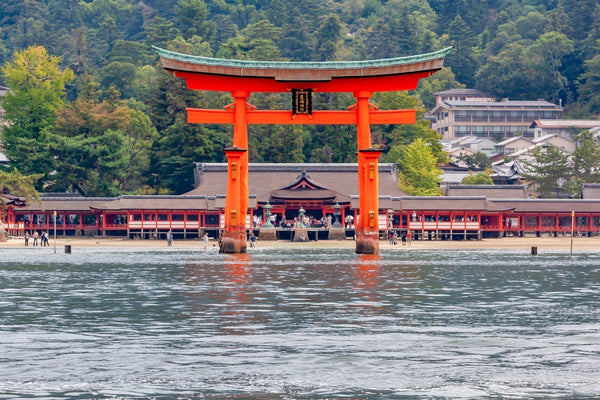
Jump to:
Shinto shrines, or jinja, are sacred spaces at the heart of Japan’s culture and spirituality. Rooted in Japan’s indigenous faith, they honor nature, ancestors, and countless deities believed to inhabit the natural world.
From quiet forests to busy city centers, shrines are more than landmarks, they’re places of reflection, ritual, and living tradition. Marked by iconic torii gates, each shrine, from tiny roadside altars to grand complexes, has its own story, style, and meaning.
This article will explore what sets Shinto shrines apart from Buddhist temples, share key etiquette tips, and highlight 15 of Japan’s most significant shrines, including Ise Jingu and Fushimi Inari Taisha.
What Is A Shrine?
Shrines are sacred spaces dedicated to the kami or spiritual beings/deities central to Shinto, Japan's indigenous religion. These shrines trace their origins to ancient animistic beliefs, where natural sites like mountains and forests were revered as dwelling places for the kami. Over time, such spaces were formalized into the architectural structures recognized today.
Shrines serve not only as centers for worship but also as cultural hubs for festivals, rituals, and the preservation of traditions, reflecting their deep-rooted significance in Japanese society.
Architecturally, shrines are designed to harmonize with their natural surroundings, embodying simplicity and purity. A torii gate marks the entrance, symbolizing the transition from the mundane to the sacred.
Beyond this lies the honden, the inner sanctuary that houses the kami and forms the spiritual heart of the shrine. Visitors often express their hopes and prayers by writing on ema, small wooden plaques hung on shrine grounds.
Additionally, kagura, a form of sacred dance, is performed during rituals to honor and entertain the kami.
These elements combine to create an atmosphere of tranquility and reverence. Shrines remain pivotal in connecting individuals with nature, spirituality, and community, continuing to uphold their enduring role in Japanese spiritual life.
How Does A Shinto Shrine Differ From A Buddhist Temple?

Shinto, Japan's indigenous faith, revolves around the veneration of kami, spirits deeply connected to nature, ancestry, and concepts like purity and harmony.
Practices at shrines typically involve purification rituals, offering prayers and gratitude to the kami, and participation in communal festivals.
Architecturally, shrines are characterized by the iconic torii gate, marking the entrance to a sacred space often built with natural materials and featuring an open layout with the honden as the central sanctuary.
Buddhism, introduced from mainland Asia, focuses on the pursuit of enlightenment and liberation from suffering through the teachings of the Buddha.
Practices at temples often include meditation, chanting of sutras, and the offering of incense, guided by Buddhist monks.
Temples are often distinguished by towering pagodas, elaborate main halls (hondō or kondō) housing Buddhist statues, and a generally more complex architectural style.
In short, shrines honor nature and spirits; temples seek spiritual awakening. Each with its own unique rituals, atmosphere, and architectural beauty.
How To Pray At Japanese Shrines?

When praying at a Japanese shrine, visitors observe a straightforward yet respectful ritual. Upon arrival, the first step is purification at the temizuya (water basin), where hands and mouth are rinsed to cleanse oneself.
At the main shrine, a small offering, typically a coin, is placed in the offering box.
Following this, the sequence is as follows: bow twice, clap twice, silently offer a prayer or wish, and bow once more.
This ritual, known as ni-rei, ni-hakushu, ichi-rei, embodies humility and reverence toward the kami. Although specific practices may differ slightly depending on the shrine, adhering to this etiquette ensures a respectful and meaningful experience.
15 of the Most Important Shrines in Japan
We will now look at fifteen of the most important shrines in Japan, separating them by type.
Imperial Shrines
These shrines share a deep connection to the Imperial family and ancient Shinto tradition.
1. Ise Grand Shrine

The Ise Grand Shrine, or Ise Jingū, located in Mie Prefecture, is one of Japan’s most revered Shinto sites, dedicated to Amaterasu, the sun goddess. With a history spanning over 2,000 years, it embodies the spiritual and cultural heart of Japan.
The shrine complex consists of the Inner Shrine (Naiku) and Outer Shrine (Geku), both harmoniously integrated into their natural surroundings. Renowned for its distinctive Yuiitsu-Shinmei-zukuri architecture, the structures are built from untreated Japanese cypress, emphasizing purity and simplicity.
Every 20 years, the shrine is ritually rebuilt in a tradition called Shikinen Sengu, symbolizing renewal, continuity, and the impermanence central to Shinto belief.
2. Meiji Jingu Shrine

Meiji Jingu Shrine, dedicated to Emperor Meiji and Empress Shoken, was founded in 1920, marking a relatively recent chapter in Japan’s history that underscores its journey toward modernization.
Designed in the traditional nagare-zukuri style, its architecture features Japanese cypress and copper, embodying simplicity and harmony with nature. The imposing wooden torii gates, among the largest in Japan, serve as symbolic thresholds to the sacred realm.
Representing the ideals of the Meiji Restoration, the shrine honors the Emperor and Empress for their pivotal roles in modernizing Japan while preserving its cultural identity.
Surrounding the shrine is a lush, man-made forest, nurtured by trees donated from across the country, symbolizing national unity and peace. Nestled within the bustling cityscape of Tokyo, Meiji Jingu offers a serene haven, blending tradition and modernity in perfect harmony.
3. Izumo Taisha Shrine

Located in Shimane Prefecture, Izumo Taisha stands as one of Japan's most ancient and revered Shinto shrines, potentially dating back to the 8th century or earlier. It is dedicated to Okuninushi, the deity associated with nation-building and matchmaking.
The shrine's architecture exemplifies taisha-zukuri, the oldest style of shrine construction, characterized by its elevated floor, substantial cypress pillars, and a prominent gabled roof. A massive shimenawa, or sacred rope, adorns the worship hall, symbolizing purity and the division between the sacred and the everyday.
Central to Shinto mythology, Izumo Taisha is also the site of the annual Kamiari Festival, a gathering of deities from all over Japan.
4. Kamigamo Shrine

Kamigamo Shrine, situated in Kyoto, ranks among Japan’s oldest Shinto shrines, dating back to the 7th century. Dedicated to Kamo Wake-ikazuchi, the deity of thunder, it has long been revered for protecting Kyoto.
The shrine showcases the traditional nagare-zukuri architectural style, distinguished by its asymmetrical roof extending gracefully over the building’s front. A notable feature of Kamigamo Shrine is the pair of sand cones (tatesuna) placed before the main hall, representing purification and the sacred Mount Kōyama.
The shrine also holds a central role in the annual Aoi Matsuri, one of Kyoto's three major festivals, celebrated each May.
Inari Shrines
These shrines, marked by red torii gates, are dedicated to Inari, the kami of rice, agriculture, and business prosperity.
5. Fushimi Inari Shrine

Fushimi Inari Taisha, nestled in Kyoto, is one of Japan’s most iconic Shinto shrines, dedicated to Inari, the deity of rice, agriculture, and prosperity. Founded in 711, it holds deep roots in Japan’s agrarian traditions.
The shrine is famous for its striking pathways of thousands of vermilion torii gates that wind up sacred Mount Inari. Its architecture includes classic Shinto features such as the honden (main hall) and the Romon Gate, donated by Toyotomi Hideyoshi in 1589.
Fox statues, believed to be Inari’s messengers, symbolize protection and abundance. Fushimi Inari remains a vibrant emblem of spiritual devotion and cultural heritage.
If you’re planning a visit, check out this helpful Kyoto travel guide for tips on what to see and do in the area, including other must-visit spots near the shrine.
6. Motonosumi Inari Shrine

Motonosumi Inari Shrine, dramatically set along the rugged coastline of Yamaguchi Prefecture, was established in 1955, making it a modern yet spiritually significant site. Its most striking feature is the row of 123 vivid red torii gates stretching down a cliff toward the Sea of Japan, forming a stunning tunnel-like path.
Dedicated to the spirit of a white fox, an Inari messenger, the shrine is associated with good fortune, business success, safe travel, and wish fulfillment.
A notable highlight is the offering box atop the final gate, said to bring extra luck if a coin lands inside, adding charm to its spiritual allure.
Kumano Shrines
Kumano shrines are a network of ancient Shinto sites in Japan that serve as spiritual centers of pilgrimage, blending nature worship with Buddhist and Shinto beliefs.
7. Kumano Nachi Taisha Shrine

Kumano Nachi Taisha, nestled in Wakayama Prefecture, is a revered Shinto shrine and part of the UNESCO-listed Sacred Sites and Pilgrimage Routes in the Kii Mountain Range.
Closely linked to Nachi Falls, Japan’s tallest waterfall, the site has been a place of nature worship for centuries. The shrine’s traditional Shinto architecture blends seamlessly with its lush, forested surroundings. A sacred camphor tree and vivid vermilion buildings enhance its spiritual atmosphere.
Symbolizing the harmony between nature and the divine, Nachi Falls is seen as a source of purification. The shrine continues to draw pilgrims and visitors seeking reflection, blessing, and natural beauty.
Maritime and Travel-Related Shrines
This section covers shrines with connections to sea travel, fishing, or safe travel.
8. Itsukushima Shrine

Itsukushima Shrine, located on Miyajima Island, traces its origins to 593 AD and rose to prominence in the 12th century under Taira no Kiyomori, who helped shape its present form.
Built in the elegant shinden-zukuri style, the shrine appears to float above the sea with its pier-like corridors and buildings set on stilts. Its iconic offshore vermilion torii gate marks the threshold between the sacred and the secular.
Dedicated to three sea goddesses, the shrine has long been associated with maritime safety. Its seamless integration with the surrounding landscape reflects a deep respect for nature and spiritual harmony.
9. Kompirasan Shrine

Kompirasan Shrine, also known as Kotohira-gū, is a revered Shinto site in Kagawa Prefecture, dedicated to Ōmononushi, the deity of seafaring. With origins tracing back to the 1st century, it holds deep historical significance.
Set atop Mount Zōzu, the shrine is reached by ascending 1,368 stone steps, a journey seen as an act of spiritual purification. Its architecture reflects a blend of Shinto and Buddhist influences, echoing its syncretic past before their separation in the Meiji era.
Symbolizing protection for sailors, the shrine features ema and maritime artifacts, serving as a heartfelt tribute to those who braved or were lost at sea.
10. Sumiyoshi Taisha

Sumiyoshi Taisha in Osaka is among Japan’s oldest shrines, established before the arrival of Buddhism. It features the distinctive Sumiyoshi-zukuri architectural style, an ancient, purely native design marked by straight, gabled roofs, forked finials (chigi), and decorative roof logs (katsuogi).
Unusually, its main halls are aligned in a straight row facing west, setting it apart from typical shrine layouts. The shrine enshrines three kami of seafaring and one linked to Empress Jingu, symbolizing maritime safety, protection, and national prosperity.
With its historical depth and unaltered design, Sumiyoshi Taisha stands as a vital example of early Japanese religious and architectural tradition.
If you want to explore the surrounding city, don’t miss this Osaka travel guide packed with local highlights and hidden gems!
Mythological or Site-Specific Shrines
This category covers shrines associated with specific myths, natural features, or sacred sites.
11. Amano Iwato Shrine

Amano Iwato Shrine, nestled in Takachiho, Miyazaki Prefecture, is a revered Shinto site deeply rooted in mythology. It is dedicated to Amaterasu, the sun goddess, and is famously linked to the cave where she once hid, casting the world into darkness.
The shrine serves as a spiritual focal point for honoring this tale of concealment and return of light. Blending seamlessly with its forested setting, the shrine features traditional Shinto architecture.
Nearby, the Amanoyasukawara cave, filled with stacked stones left by pilgrims, enhances the shrine’s mystical aura. Symbolically, it embodies light, renewal, and humanity’s enduring connection to the divine.
12. Matsunoo Taisha

Matsunoo Taisha in Kyoto dates back to the 7th century, predating the city’s rise as Japan’s capital. Its architecture reflects early Shinto nature worship, incorporating a sacred spring and a revered rock formation, both seen as direct embodiments of the kami.
While it includes traditional shrine structures, these natural features set it apart, emphasizing the spiritual significance of the landscape itself. Symbolically, Matsunoo Taisha is closely tied to sake brewing and agricultural prosperity, with the enshrined deities believed to bless these pursuits.
The shrine’s fusion of built and natural elements highlights Shinto’s deep-rooted reverence for the life-giving power of nature.
Historical or Politically Significant Shrines
This section covers shrines tied to notable historical figures or people in history with controversial roles.
13. Toshogu Shrine

Toshogu Shrine, located in Nikko, Tochigi Prefecture, is a magnificent Shinto shrine dedicated to Tokugawa Ieyasu, the founder of the Tokugawa Shogunate. Built in 1617 and later expanded by his grandson Tokugawa Iemitsu, the shrine reflects the grandeur of the Edo period.
Its elaborate architecture, adorned with intricate carvings and gold leaf, stands out from the simplicity typical of Shinto shrines. The Yomeimon Gate, known for its exquisite detail, is a highlight of the complex.
Symbolically, Toshogu Shrine represents the unification and stability brought by Ieyasu’s rule. Iconic carvings, such as the “Sleeping Cat” and the “Three Wise Monkeys,” convey vigilance and moral principles. Surrounded by towering cedar trees, the shrine harmonizes with its natural setting, embodying the coexistence of spirituality and nature.
Recognized as a UNESCO World Heritage Site, Toshogu Shrine remains a testament to Japan’s historical and cultural legacy.
14. Yasukuni Shrine

Yasukuni Shrine in Tokyo was established in 1869 to honor the spirits of those who died serving Japan, primarily in military conflicts. Its grounds feature a large torii gate, a main hall (honden), and the Yūshūkan museum, which displays war-related artifacts. While architecturally traditional, the shrine carries deep and complex symbolism.
Controversy surrounds the enshrinement of individuals convicted of war crimes alongside millions of other war dead, leading to tensions with countries affected by Japan’s wartime actions. For some, it stands for remembrance and national pride; for others, it represents unresolved historical issues. As such, Yasukuni remains a powerful and sensitive symbol in Japan’s modern narrative.
Kasuga-Style Shrines
These shrines are noted for their specific architectural style and ties to noble clans.
15. Kasuga Shrine

Kasuga Taisha, located in Nara, is a historic Shinto shrine founded in 768 CE and dedicated to four kami, including Takemikazuchi, the thunder deity. It served as the guardian shrine of the powerful Fujiwara clan.
The shrine is famed for its distinctive Kasuga-zukuri architecture, featuring gracefully sloping roofs and vivid vermilion pillars that stand out amid the surrounding forest. Symbolizing harmony between nature and the divine, the shrine is also home to sacred deer, believed to be messengers of the gods. Thousands of stone and bronze lanterns donated by worshippers glow during festivals, creating an ethereal atmosphere.
As part of the UNESCO-listed Historic Monuments of Ancient Nara, Kasuga Taisha remains a treasured cultural and spiritual site.
Visiting Japanese Shrines

Exploring Japanese shrines provides a fascinating insight into the nation’s spiritual and cultural heritage. The most popular time for visits is during the New Year (Hatsumode), when millions gather to pray for blessings and prosperity.
Throughout the year, festivals (matsuri) offer lively occasions to immerse oneself in shrine culture, featuring traditional performances, food stalls, and ceremonies. Spring and autumn, with their blooming cherry blossoms and vibrant foliage, are especially ideal for visiting.
Observing proper etiquette is essential. Bow once at the torii gate before entering and stay to the side of the path, reserving the center for the deities. At the purification basin, cleanse your hands and mouth.
In the main hall, offer a coin, bow twice, clap twice, make a silent prayer, and bow once more. Maintain quiet and respectful behavior, and note that photography may be restricted in certain areas.
Shrines: The Sacred Heart of Japan
Shrines are more than places of worship—they’re where Japan’s spiritual and cultural identity lives and breathes. Rooted in Shinto, they reflect a deep reverence for nature, tradition, and community.
From the grand Ise Jingu to the red gates of Fushimi Inari, each shrine tells a story through its architecture, rituals, and connection to the kami, or spirits.
Visiting a shrine can leave a lasting impression... the stillness, the scent of incense, and the sense of connection to something timeless.
Want to bring that feeling home?
I recommend getting this Japanese incense from Kousaido. It comes in a seasonal gift box with four beautifully crafted scents, perfect for quiet reflection or creating a peaceful mood at home. If you’re new to incense or curious about its cultural roots, this beginner’s guide to Japanese incense and Kōdō is a great place to start.
If you are looking for other meaningful keepsakes, get this Japanese bookmark and lucky charm, with a daruma doll print, or this elegant folding fan featuring a torii gate and fox mask, the symbols often seen at Inari shrines.
Do you a favorite shrine in Japan? Let us know in the comments!


0 comments